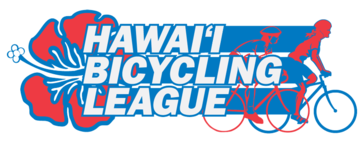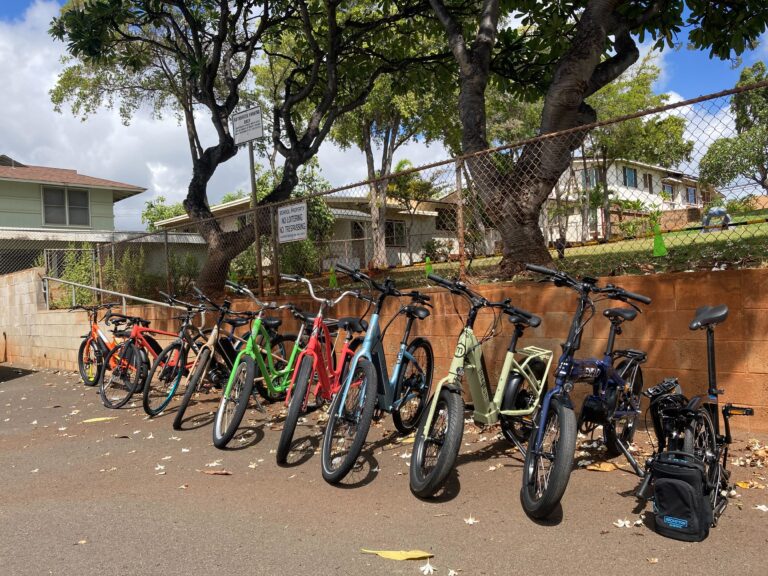There is so much information out there about e-bikes it can be overwhelming, so HBL has boiled it down to the hottest topics for Hawai‘i. This page covers:
» What is an e-bike?
» Where can e-bikes be ridden?
» E-bike lingo
» E-bike safe cycling tips & etiquette
» E-bike Fast Facts
E-bike 101: The Essentials.
E-bikes 101
What is an electric bike?
An e-bike (or electric bicycle) can look a lot like a traditional bicycle except an e-bike is with an electric motor and rechargeable battery to provide the rider a power boost for climbing hills or traveling long distances. Many e-bikes provide assistance only when the rider is pedaling, while others have throttles and assist regardless of whether or not the pedals are being turned.
Currently, Hawai‘i legally recognizes e-bikes as “low-speed electric bicycles,” as defined under title 15 United States Code section 2085 which clarifies the the term “low-speed electric bicycle” to mean:
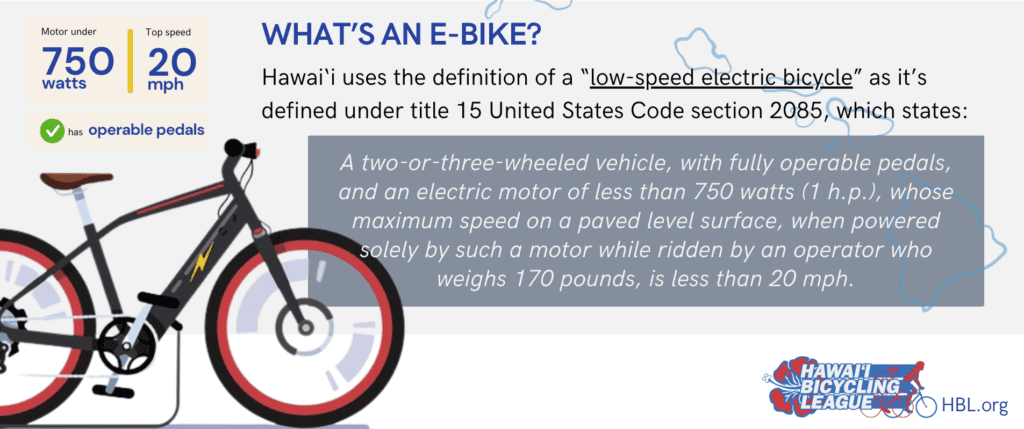
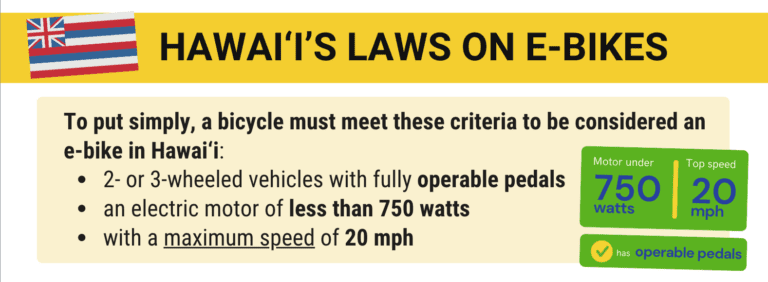
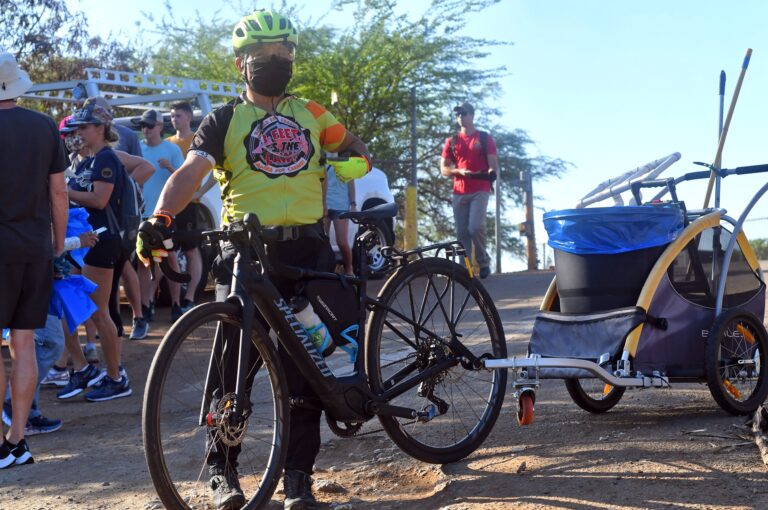
Benefits of E-bikes
E-bikes can make riding a bicycle for fun, commuting, and transportation easier and more convenient; and allow current bicycle users to bike more often and farther. The electric motor makes pedaling easier so folks can ride with less effort, helping people:
- With medical condition(s) or physical challenges be able to ride
- Conquer steep hills or challenging terrain
- Increase fitness / start cycling or get riding more often
- Easily carry heavy loads (kids, groceries, gear, etc.)
- Feel safer when they can keep up with traffic
- Reduce the need to use a motor-vehicle
- Get more biking more often!
E-Bikes 101 - Free Workshop (for adults)!
Get brought up to speed on the essentials of e-bikes – before you get up to speed on an e-bike!
Electric bicycles are giving more people access to the awesome world of bicycling – but there are key differences that you should know about. This 2-hour interactive workshop will go over the most essential e-bike topics, covering what Hawai‘i’s laws say about e-bikes, introduction & rundown of e-bike lingo, what sets them apart from traditional bicycles, pros & cons on different component options, and best practices for safe e-biking in Hawai‘i!
This workshop includes:
A variety of e-bikes (different types, styles, & features) to try out
JUNE 2025
AUGUST 2025
OCTOBER 2025
Where are e-bikes allowed?
In Hawai‘i, a low-speed electric bicycle may be operated in any place where a bicycle is allowed to operate,
including but not limited to streets, highways, roadways, shoulders, bicycle lanes, bikeways, and bicycle or multi-use paths. E-bikes have the capability to move people faster than traditional bicycles, so e-bike riders need to use caution, especially on trails or areas where drivers may not expect a bicycle rider to be moving as fast.
REMINDER: All bicycles (including low-speed electric bicycles) must be registered with the City & County in order to be considered a legal vehicle, permitted on our public roadways.
Who are e-bikes for?
The Minimum Age to E-bike is 15 in Hawai‘i.
In Hawai‘i, persons 15 years and older* may operate an e-bike if it is registered to a household member (you must at least 18 years old to register a bicycle). *Note that helmets are required for anyone e-biking in Honolulu county under the age of 18.
No Packing.
Only one person should be riding an e-bike at a time (the person operating it), unless your e-bike is specifically equipped to carry additional passenger(s).
“The bicyclist must ride on the permanent, regular seat attached to the bicycle. No bicycle shall be used to carry more persons at one time than the number for which it was designed and equipped.” §291C-143 Riding on bicycles.
E-bike Safety
E-bikes on the surface may look almost undistinguishable from your standard bicycle, but the added weight and extra power from the battery means the rider needs to ramp up their riding awareness or risk causing injury to themselves & other roadway users. You should use caution when traveling faster than a speed you normally would, especially on trails or areas where motor vehicles may not expect you to be moving as fast. Your safety and the perception of bicyclists depend on you.
START SMART.
E-bike safety starts even before you get riding!
- Follow the rules of the road as you would on a traditional bicycle ("drive" your e-bike!).
- Expect longer stopping distances due to the increased weight of an e-bike.
- If transporting an e-bike, make sure your bike rack can take the weight. Remove the e-bike battery if it is external to the bike frame.
- Store your battery out of the elements & direct sun.
- Take time to get comfortable with the sudden boost of speed when the motor assist kicks in.
Safe Cycling Tips for E-Bike Riders:
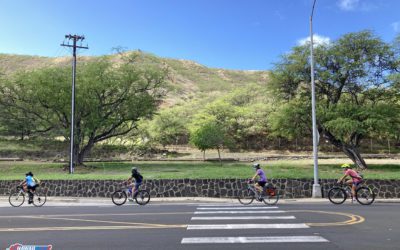
Riding on the roads of Hawai‘i:
Things to keep in mind when riding on the street with cars:
- » Know what the rules of the road are, and follow them.
- » Ride on the right side of the road and never against traffic.
- » Stop at stop signs and — most importantly — yield the right-of-way when it is required.
- » As it is, many drivers underestimate how fast a bicycle can move – so on an e-bike, you’ll need to be extra vigilant & ride defensively, assuming others don’t see you.
- » The most important safety tip is to ride in a predictable manner with respect for others safety.
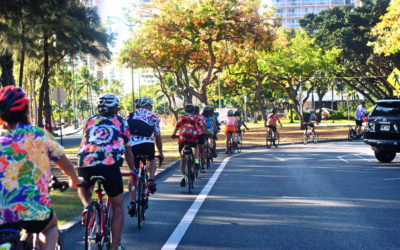
Using bicycle infrastructure:
Things to keep in mind when using bike infrastructure:
- » If you choose to utilize riding in bike facilities, be sure to practice good rider etiquette. Before passing a slower cyclist, give a clear head’s up in advance (audible “passing on your left” is perfect!), and slow your speed down before overtaking, giving them space when you go around them.
- » Bicycle infrastructure like bike lanes, protected bike lanes, and multi-use paths are built for pedaling people to have a place they feel comfortable to cruise along in, so if you’d like to travel at higher speeds with your e-bike, we encourage you to consider riding where the faster flow of traffic is (on the road).
TAKE A FREE E-BIKE WORKSHOP
E-bike video series
A 5-part educational video series created by Hawai‘i Bicycling League with funding from Hawai‘i Department of Transportation.
E-Bike Basics
Learn what is considered an e-bike in Hawai‘i (and what is not), where they can be operated, and what sets them apart from traditional bicycles.
Where Can I Ride My E-Bike?
Where are e-bikes allowed? This video covers where e-bikes can be ridden in Hawai‘i and best practices when sharing the road with others.
E-Biking Tips For First Time Riders
While e-bikes can look a lot like the bicycles you grew up with, there are some crucial differences that you need to know to stay safe and have fun with your e-bike. Check out HBL’s top 5 tips to bring you up to speed before you get to speed with your new electric vehicle.
E-Bike Battery Safety
Our friends at the Honolulu Fire Department share top five e-bike charging tips that can help prevent dangerous lithium-ion battery fires but also help prolong the range of your e-bike.
Tips When Buying Your First E-Bike
Thinking about getting an e-bike? Here are five tips to help you make an informed decision when purchasing an e-bike in Hawai‘i.
E-BIKE LINGO
common phrases & other e-bike terminology
Main E-bike Parts
Electric MOTOR
The motor is the component that spins the wheels.
The motor is compact and can be built into the hub of the back or front wheel, or mounted in the center of the bike.
Rechargeable BATTERY
Modern electric bike batteries are typically made with lithium-ion technology, which has a high energy density, lightweight nature, and reliable performance. The capacity of the battery is measured in watt-hours (Wh) and determines the range on a single charge.
E-bike batteries can be positioned on the down tube, on the rear rack, or integrated inside the down tube. Bikes with batteries hidden inside the frame look sleek and modern, but typically cost a bit more.
CONTROLLER
The controller is the electronic brains of the e-bike, it monitors speed, acceleration, power, battery voltage, pedal activity, pedal assist, etc. It interprets rider inputs and regulates motor performance to ensure safe smooth power delivery.
E-bikes are normally outfitted with a handlebar mounted digital display, basically a mini dashboard. The display is where the rider will see important system information relayed from the controller like battery status, speed, pedal assist modes, etc.
THROTTLE
In addition to the motor being activated by pedaling, some e-bikes are also equipped with a throttle that allows the rider to operate the motor without pedaling at all.
The throttle is located on the handlebars and can be twist grip or thumb operated.
SENSOR
The sensors on an electric bike are the main way the motor communicates with the rest of the components. The sensors analyze the rider’s pedaling input, which activates the motor and provides assistance.
The two main types of e-bike sensors are cadence and torque sensors. Basically, a speed or cadence sensor detects if you’re pedaling, and a torque sensor measures how hard you’re pedaling.
Common E-bike Terms
pedal-assist
Pedal assist is an operating mode on an e-bike that engages the motor to deliver power to help you pedal easier and go faster. With pedal assist, the motor engages only when the pedals are being rotated (the rider must pedal to get power).
range
Range is the distance or time a battery will last. Range is primarily determined by battery capacity (Wh), but it’s also affected by the total weight of the bike and rider, the terrain (hilly vs. flat), and the drive mode (Eco vs. Boost).
» Range of distance for one battery charge is 25-120+ miles. This caries greatly due to total weight carried on the bike, terrain, traveling speed, and other factors.
modes / drive modes
Most e-bikes offer different levels of pedal-assistance from the motor, called “modes” or “drive modes.” These modes can be selected using a handlebar-mounted switch and are usually visible on a handlebar-mounted display.
» Common names for these modes are (offers less assistance) Eco, Standard / Trail, and Boost / Turbo (offers greater assistance). Eco mode reduces the level of pedal assistance and increases battery life. Boost / Turbo mode increases the level of pedal assistance to improve acceleration but reduces battery life.
Power (watts)
Power is the amount of work that can be done by the e-bike motor. It can be thought of as a torque multiplied by RPM (i.e., pedaling cadence).
Torque (Nm)
For e-bikes, torque refers to the maximum force the motor can apply to turn the rear wheel. Measured in newton meters (N m), torque is a turning force that causes rotation (i.e., rotating the rear wheel.).
» Torque is a spec to check if you plan to ride a lot of hills and/or haul heavy loads. Your actual riding torque will vary, though, as you change your pedal-assist settings.
Class
Many states have created “classes” of e-bikes that are subject to different regulations based on speed and other factors. In most states, including Hawai‘i, Class 1 & Class 2 e-bikes are regulated as traditional bicycles.
(Read more below)
In the US, a legal e-bike must have operable pedals, meaning you can pedal it with or without any motor assistance, and a motor with no more than 750 watts of power. Electric bikes are categorized into three e-bike classes based on three main criteria: top speed, type of assistance, and motor power. These classes are:
Class 1
The motor requires the rider to pedal in order to provide power (there is NO throttle), and the motor stops providing assistance when the e-bike reaches 20 mph.
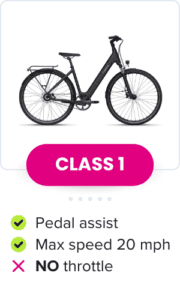
(Example of Class 1)
✓⃝ Meets criteria of a low-speed electric bicycle & can be registered as an e-bike in Hawai‘i
Class 2
An e-bike similar to Class 1 e-bikes (has a pedal-assist mode up to 20 mph); but in addition they also offer a throttle-powered mode that doesn’t require pedaling.
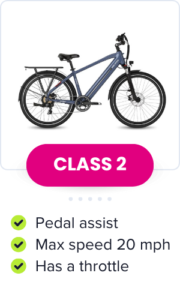
(Example of Class 2)
✓⃝ Meets criteria of a low-speed electric bicycle & can be registered as an e-bike in Hawai‘i
Class 3
Also called a “speed pedelec”, this vehicle has a motor that ceases to provide assistance when the e-bike reaches 28 mph. Must have a speedometer, and may or may not have a throttle.
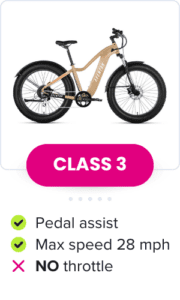
(Example of Class 3)
Any vehicle that does NOT fit into the three class definitions falls into the “Unclassified” category & may not be legally considered an e-bike.
NOT an E-bike
In Hawai‘i, if it goes faster than 20mph (with the rider not having to pedal), is equipped with a motor more than 750 Watts, or it does not have operable pedals, it is NOT legally considered an e-bike and should only be operated on private lands where you have permission.

❌ Is NOT considered a low-speed electric bicycle
E-BIKE FAST FACTS
Questions about e-bikes? we have answers.
Here’s a quick recap of answers to the most common questions asked about electric bikes in Hawai‘i.
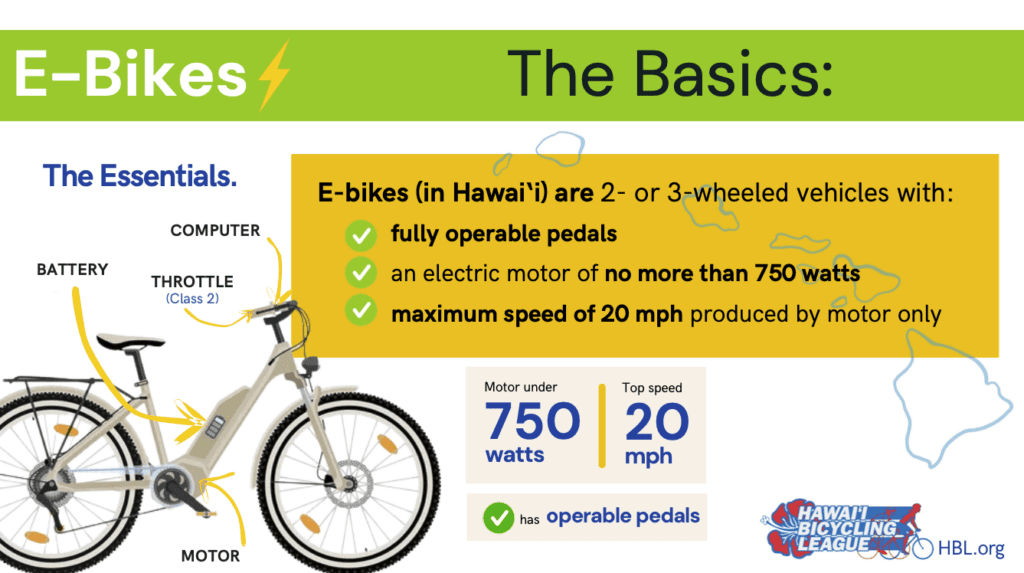
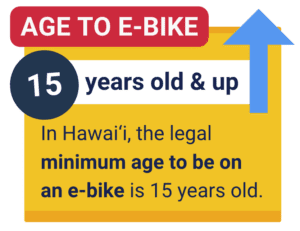
Minimum Age
In Hawai‘i, you must be at least 15 years old to legally ride an e-bike.
Registering your vehicle
You are required to register your e-bike to operate it on public roadways. It costs $30 (one-time fee) to register an e-bike. More info on bicycle registration here.
Where Allowed
E-bikes are allowed on any roadway, lane, or path that traditional bicycles are allowed on, including shared-use paths.
Do you need to pedal?
E-bikes that are Class 2 have a throttle feature which the rider could use to engage the motor without pedaling. If the e-bike does not have a throttle, the rider must pedal to activate the boost from the motor.
Helmet Requirement
 A properly fastened helmet is required for anyone on an e-bike under the age of 18 years in Honolulu county.
A properly fastened helmet is required for anyone on an e-bike under the age of 18 years in Honolulu county.
Speed Limit
If the motor goes faster than 20 mph, Hawai‘i doesn’t consider it an “e-bike”, and therefore cannot be registered to ride on public streets. Note: the motor will cease providing assistance at it’s “top assisted speed”, but the rider can keep pedaling faster to make the e-bike go faster.
License to drive?
Driver’s license and insurance is not required.
Mopeds, dirt bikes, and motorcycles
These vehicles are NOT the same as e-bikes because they have motors that make them capable of going over 20 mph, are more than 750 watts (1 hp), and do not have pedals that function.
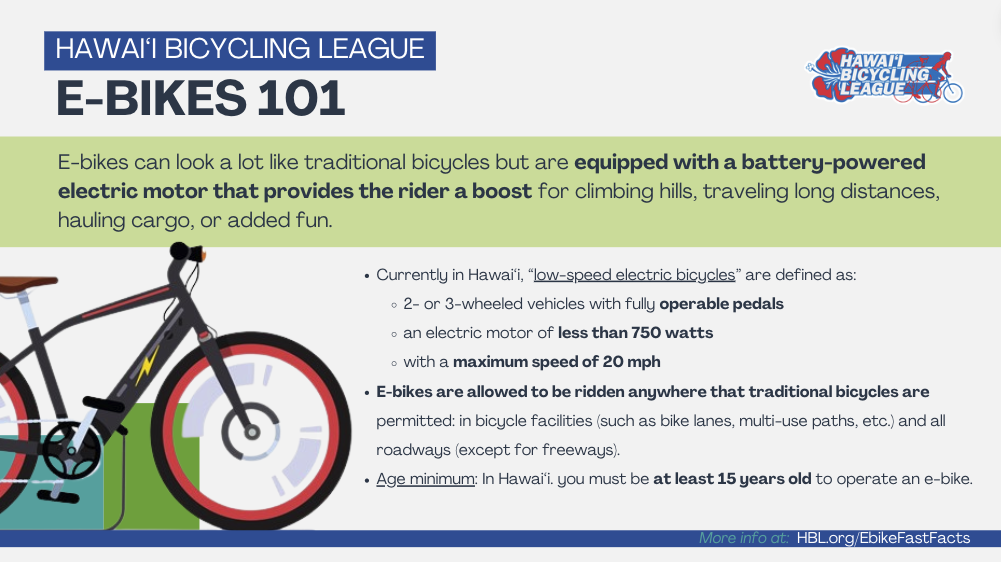
more resources
- Bill 52 Passed (Feb. 2025) - Learn what this mean for e-bikes?
- ACT 208 / HB812 - How Hawai‘i defines "low-speed electric bicycles" (legal text)
- Guide on how to register your bicycle / e-bike in Hawai‘i
- Info on Hawai‘i's Electric Bike & Moped Rebate
- Brush up on all the bike laws for Hawai‘i: Bicycle Regulations, Hawai'i Revised Statutes
- Find out when the next free on-bike workshop is with HBL!

